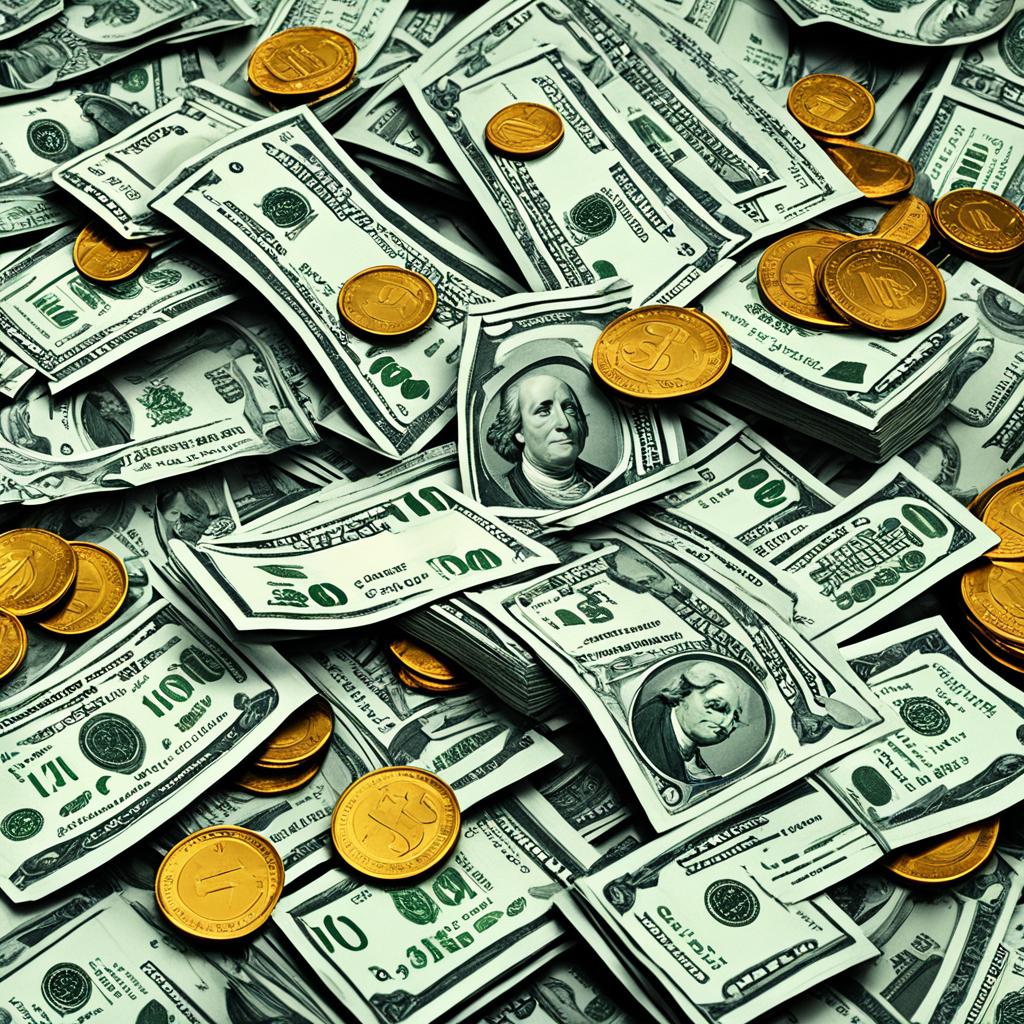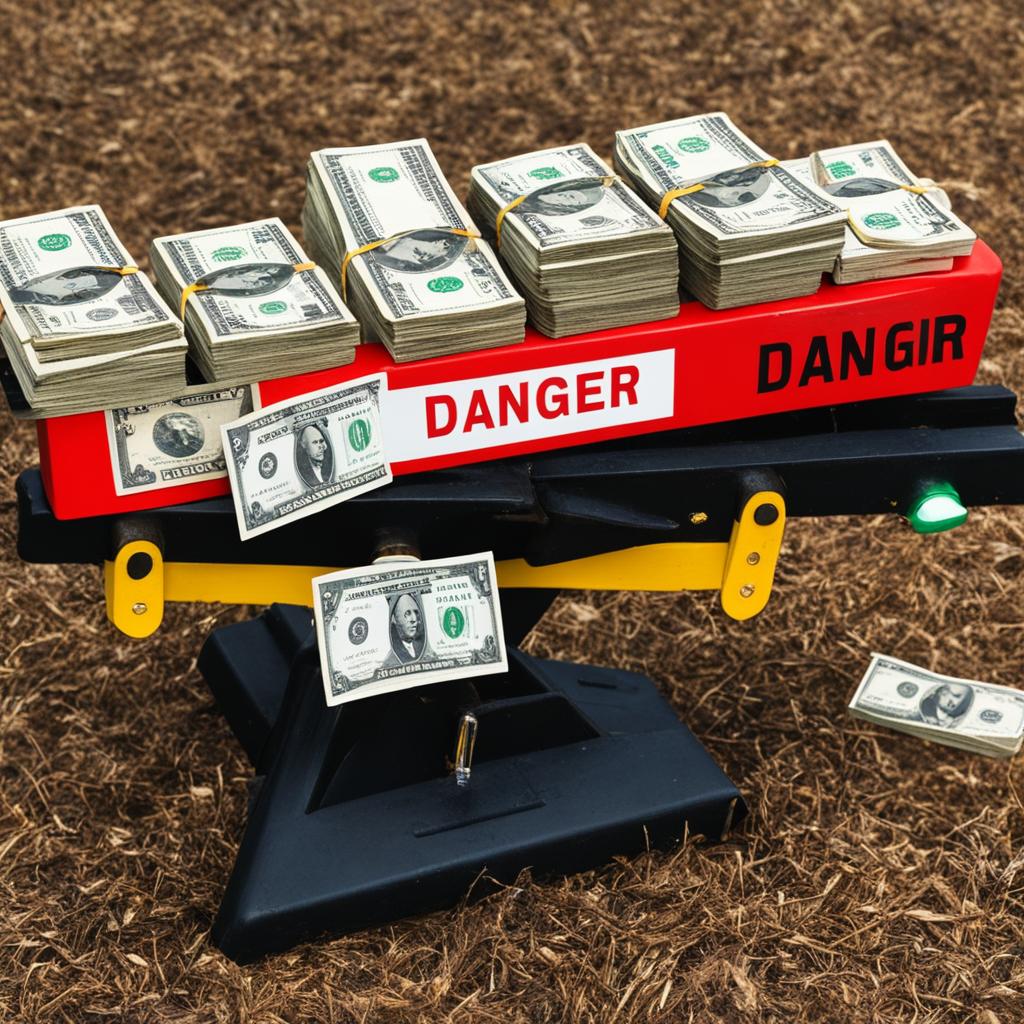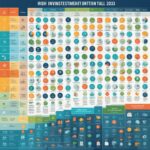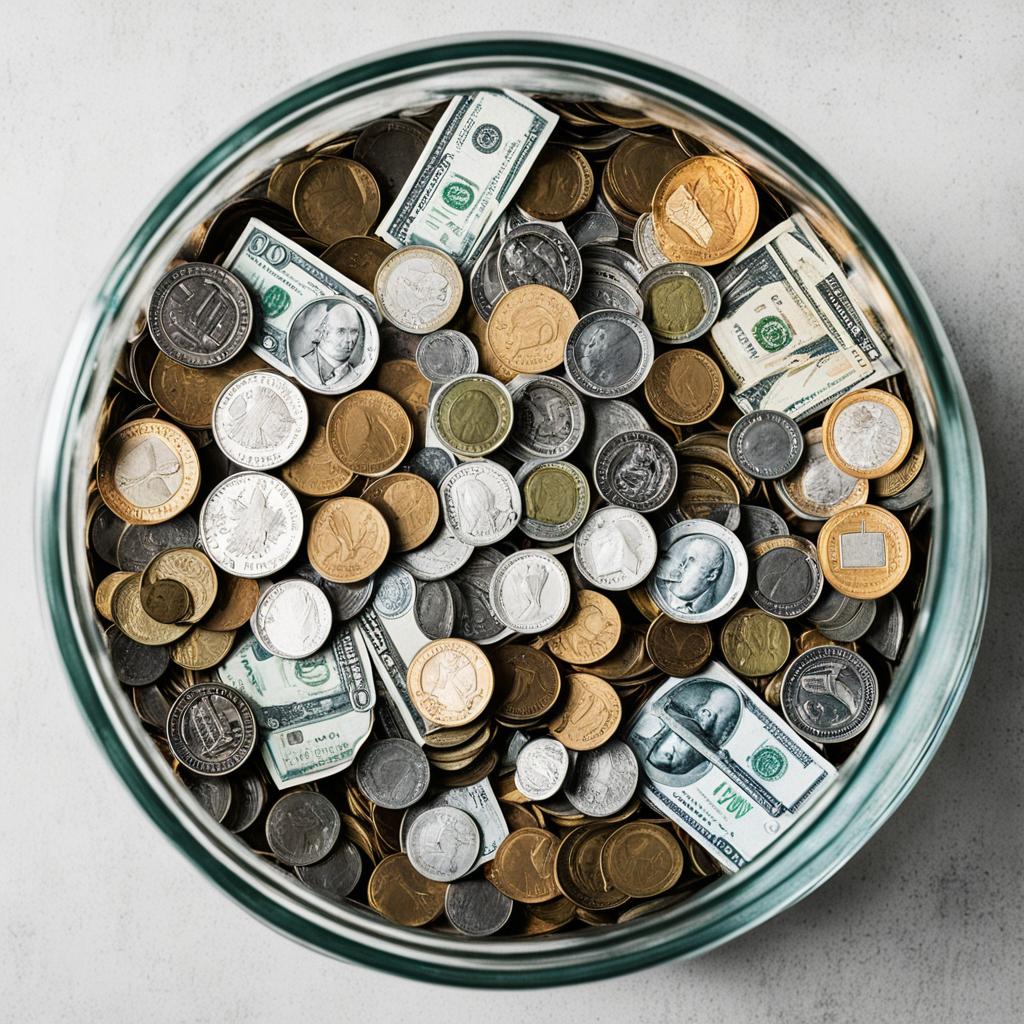Hi, I’m here to talk about investing your emergency fund. We all know how important it is to have an emergency fund to cover unexpected expenses. But have you ever thought about making your emergency fund work for you and potentially earn some extra money?
When it comes to investing your emergency fund, there are a few key factors to consider. One of the most important things is to choose investment options that are easily accessible and liquid. You want to be able to access your funds quickly in case of an emergency, so it’s best to avoid volatile investments.
Instead, focus on more stable assets that still offer opportunities for growth. Money market accounts, high-yield savings accounts, and certificates of deposit (CDs) are all great options to consider. These investments provide a balance between earning money and maintaining liquidity.
Next, let’s dive into the benefits of liquidity and why it’s crucial for your emergency fund investments.
Key Takeaways:
- Investing your emergency fund can potentially help you earn extra money.
- Choose investments that are easily accessible and liquid.
- Avoid volatile investments and focus on stable assets.
- Consider money market accounts, high-yield savings accounts, and CDs as investment options.
- Liquidity allows you to access your funds quickly in case of an emergency.
The Benefits of Liquidity for Emergency Funds
When it comes to investing your emergency fund, one crucial aspect to consider is maintaining liquidity. The last thing you want is to have your money tied up in investments that are difficult to access when you need them the most. That’s why it’s important to choose investment options that provide a balance between earning potential and easy access to your funds in case of an emergency.
There are several investment options that offer the benefits of liquidity for your emergency fund:
- Money Market Accounts: These accounts are a popular choice for emergency fund investments. They offer competitive interest rates and typically allow you to write checks or withdraw funds whenever needed. Money market accounts are considered low-risk investments and provide the flexibility you need without sacrificing returns.
- High-Yield Savings Accounts: Another option for securing your emergency fund is a high-yield savings account. These accounts offer higher interest rates compared to traditional savings accounts, allowing your emergency fund to grow while still maintaining easy access to your money. Online banks often offer competitive rates for high-yield savings accounts, making them a viable choice for investors.
- Certificates of Deposit (CDs): CDs can also be a good option for investing your emergency fund. They offer higher interest rates than regular savings accounts and provide a fixed rate of return over a specific term. While CDs may have penalties for early withdrawals, they can be an effective tool for securing your funds and earning a consistent return.
By investing in these options, you can enjoy the benefits of liquidity while maximizing the returns on your emergency fund. These investments provide a balance between safety and growth, ensuring that you have access to your funds when you need them while still earning a reasonable return on your investment.
Quote:
“Investing your emergency fund in liquid assets like money market accounts and high-yield savings accounts allows you to secure your funds while still earning a return. It’s a smart way to protect yourself from unexpected expenses without sacrificing growth potential.” – Financial Advisor
| Investment Option | Liquidity | Return | Risk Level |
|---|---|---|---|
| Money Market Accounts | High | Low to moderate | Low |
| High-Yield Savings Accounts | High | Low to moderate | Low |
| Certificates of Deposit (CDs) | Low to moderate | Low to moderate | Low |
Investing your emergency fund wisely is essential for securing your financial future. By prioritizing liquidity and choosing investment options that offer a balance between easy access to your funds and potential returns, you can protect yourself from unforeseen circumstances while still growing your emergency fund.
Ways to Invest Your Emergency Funds
When it comes to investing your emergency fund, it’s important to find options that provide both growth potential and easy access to your funds. Here are some strategies to consider:
- Traditional Checking or Savings Account: Keeping your emergency fund in a traditional bank account ensures that your funds are easily accessible when you need them. While these accounts may not provide high interest rates, they offer convenience and instant liquidity.
- Money Market Accounts: Money market accounts are a popular choice for investing emergency funds. They offer higher interest rates compared to traditional savings accounts and provide easy access to your funds. Some money market accounts also come with check-writing privileges, making it convenient to withdraw money when an emergency arises.
- High-Yield Savings Accounts: High-yield savings accounts are another option to consider. These accounts, typically offered by online banks, offer competitive interest rates while still providing the flexibility to withdraw funds. They can be a great way to grow your emergency fund while keeping it safe.
- Certificates of Deposit (CDs): CDs are time-based deposits that offer higher interest rates compared to regular savings accounts. They provide a fixed return over a specific period of time, ranging from a few months to several years. While CDs can be a good option for emergency fund growth, be aware of early withdrawal penalties if you need to access your funds before the CD matures.
It’s important to carefully assess your needs and goals before deciding where to invest your emergency fund. Consider factors such as the level of risk you’re comfortable with, the ease of access to your funds, and the potential returns. Consulting with a financial advisor can also provide valuable guidance based on your individual circumstances.
Comparison of Investment Options
| Investment Option | Liquidity | Interest Rates | Features |
|---|---|---|---|
| Traditional Checking or Savings Account | High | Low | Instant access to funds |
| Money Market Accounts | High | Medium | Check-writing privileges |
| High-Yield Savings Accounts | High | Medium to high | Online access and transfers |
| Certificates of Deposit (CDs) | Low to medium | Medium to high | Fixed return over a specific period |
Remember, the purpose of your emergency fund is to provide a financial safety net during unexpected situations. Therefore, it’s essential to strike a balance between investing for growth and maintaining easy access to your funds. Consider diversifying your investments and allocating a portion of your emergency fund to different options to mitigate risks and maximize returns.
Money Market Accounts
When it comes to growing your emergency fund, one option you may consider is a money market account. These accounts are a blend of checking and savings accounts, offering attractive interest rates while providing easy access to your funds.
One of the key advantages of money market accounts is their low risk nature. They are typically insured by the FDIC (Federal Deposit Insurance Corporation) or NCUA (National Credit Union Administration), ensuring that your funds are protected.
Furthermore, money market accounts often come with additional benefits such as debit card and check-writing privileges. This means you can have instant access to your funds whenever you need them, making it an ideal option for emergency situations.
| Pros | Cons |
|---|---|
| 1. Higher interest rates compared to traditional savings accounts | 1. Limited number of transactions per month |
| 2. Low risk and insured by the FDIC or NCUA | 2. May require a higher minimum balance to earn the best interest rates |
| 3. Easy access to funds through debit card and check-writing privileges | 3. Potential fees for falling below the minimum balance |
How do money market accounts work?
A money market account works similarly to a traditional savings account. You deposit money into the account and earn interest on the balance. The interest rate is typically higher than what you would earn in a basic savings account, making it an attractive option for growing your emergency fund.
One thing to keep in mind is that money market accounts may have limitations on the number of transactions you can make each month. This is to ensure the account remains true to its purpose as a savings tool and not a checking account.
Remember, while money market accounts provide higher interest rates compared to traditional savings accounts, they are not designed for frequent transactions like a checking account. Instead, they offer the perfect balance between accessibility and earning potential for your emergency fund.
High-Yield Savings Accounts
When it comes to maximizing your emergency fund returns, high-yield savings accounts can play a crucial role. These accounts, often offered by online banks, provide higher interest rates compared to traditional savings accounts, allowing your emergency fund to grow at a faster rate.
Online-only banks typically offer high-yield savings accounts that are FDIC-insured, ensuring the safety of your funds. This means that even if the bank were to fail, your money would still be protected up to the FDIC insurance limit.
Accessing your funds in a high-yield savings account is convenient and straightforward. Online transfers, wire transfers, or checks can be used to withdraw money when needed. You can manage your account from the comfort of your own home, making it ideal for those looking for flexibility and ease of use.
With a high-yield savings account, your emergency fund can not only be secure but also generate higher returns than a traditional savings account. Take advantage of the power of compounding interest and watch your emergency fund grow over time.
Investing in a high-yield savings account is a smart choice for those seeking to maximize their emergency fund returns. With higher interest rates and easy access to funds, it’s a win-win situation.
Comparison of High-Yield Savings Accounts
| Bank | Annual Percentage Yield (APY) | Minimum Balance Requirement | Accessibility |
|---|---|---|---|
| Bank A | 2.25% | $1,000 | Online transfers, checks |
| Bank B | 2.50% | $500 | Online transfers, wire transfers |
| Bank C | 2.75% | $5,000 | Online transfers, checks |
Here is a comparison of some leading high-yield savings accounts to help you choose the one that best meets your needs:
- Bank A offers a competitive APY of 2.25%, with a minimum balance requirement of $1,000. You can access your funds through online transfers and checks.
- Bank B offers an even higher APY of 2.50%, with a minimum balance requirement of $500. Withdrawals can be made via online transfers and wire transfers.
- Bank C provides the highest APY of 2.75%, but requires a minimum balance of $5,000. However, you have the flexibility to access your funds through online transfers and checks.
Keep in mind that each bank may have additional features and benefits, so it’s essential to compare the offerings and read the terms and conditions before selecting a high-yield savings account.
Certificates of Deposit (CDs)
When it comes to investing your emergency fund, one option to consider is Certificates of Deposit (CDs). CDs are savings accounts that offer higher interest rates compared to checking accounts and traditional savings accounts. They provide a secure and low-risk way to invest your money for emergencies.
CDs are backed by the Federal Deposit Insurance Corporation (FDIC) and typically come with fixed terms ranging from a few months to several years. During this period, your money will earn interest at a predetermined rate. This makes CDs suitable for individuals who want to earn a higher return on their emergency funds while minimizing risk.
However, it is important to be aware of the early withdrawal penalties associated with CDs. If you need to access the funds before the CD matures, you may be subject to fees or forfeit a portion of the interest earned. Therefore, it’s crucial to carefully assess your emergency needs and choose a CD term that aligns with your financial goals.
To enhance the liquidity of your emergency fund, you can consider creating a CD ladder. This involves purchasing CDs with staggered maturity dates, allowing you to have regular access to a portion of your funds without incurring penalties. A CD ladder provides a flexible and strategic approach to managing your emergency fund while taking advantage of higher interest rates.
Another option is to look for banks that offer no-penalty CDs. These allow you to withdraw your funds before the maturity date without facing any penalties. While the interest rates may be slightly lower compared to traditional CDs, the added liquidity can provide peace of mind in emergency situations.
Overall, CDs can be a valuable tool for investing your emergency fund, offering higher interest rates and security. Just be sure to consider the potential penalties and explore strategies like CD ladders or no-penalty options to optimize the accessibility of your funds.

Benefits of Certificates of Deposit (CDs) for Emergency Fund Investing:
- Higher interest rates compared to traditional savings accounts
- Federal Deposit Insurance Corporation (FDIC) protection
- Low-risk investment option for emergency funds
- Potential to create a CD ladder for increased liquidity
- No-penalty CDs available for greater flexibility
“Certificates of Deposit (CDs) offer a secure and higher-yield investment option for your emergency fund. By carefully considering the terms, penalties, and laddering strategies, you can effectively balance liquidity and growth, ensuring your funds are readily available while earning a solid return.” – Financial Expert
How Much of Your Emergency Fund Should Be Liquid?
When it comes to your emergency fund, it’s important to strike a balance between growth and accessibility. Financial advisors recommend keeping at least three to six months’ worth of expenses in liquid assets. This means maintaining a portion of your emergency fund in assets that can be easily converted to cash.
While it may be tempting to invest your entire emergency fund for potential growth, having a portion in liquid assets ensures that you can access the money quickly in case of an emergency. The specific amount you allocate to liquid assets will depend on your individual circumstances and financial obligations.
Evaluating Your Individual Circumstances
When determining how much of your emergency fund should be liquid, consider the following factors:
- Income Sources: Evaluate the stability of your income sources. If you have a steady job and reliable income, you may be able to allocate a smaller portion of your emergency fund to liquid assets. However, if you rely on freelance work or have a less stable income, it’s wise to keep a larger portion of your fund in liquid assets.
- Household Size: Take into account the size of your household and the potential financial needs that may arise. If you have dependents or a larger household, you may want to keep a larger portion of your emergency fund in liquid assets.
- Job Stability: Consider the stability of your job and industry. If your job is secure and your industry is relatively stable, you may be able to allocate a smaller portion of your emergency fund to liquid assets. However, if you work in a volatile industry or have concerns about job security, it’s wise to keep a larger portion of your fund easily accessible.
By taking these factors into account, you can customize the allocation of your emergency fund to suit your unique situation.
A Balanced Approach
While it’s important to have a portion of your emergency fund in liquid assets, it’s also beneficial to consider growth strategies. By exploring investment options that offer higher returns, you can make your emergency fund work harder for you.
Consider creating a diversified portfolio that includes both liquid assets and investments. This way, you can have the peace of mind of easy access to cash while also maximizing the long-term growth potential of your emergency fund.
Comparison of Liquid Assets and Investments
| Asset Type | Liquidity | Potential Growth | Risk Level |
|---|---|---|---|
| Money Market Accounts | High | Moderate | Low |
| High-Yield Savings Accounts | High | Moderate | Low |
| Certificates of Deposit (CDs) | Medium | Low | Low |
| Stocks | Medium | High | High |
As shown in the table above, different assets offer varying levels of liquidity, potential growth, and risk. It’s important to consider your risk tolerance and financial goals when deciding how to allocate your emergency fund.
“Having a portion of your emergency fund in liquid assets ensures that you can access the money quickly in case of an emergency.”
Remember, the goal of your emergency fund is to provide immediate financial stability during unexpected situations. By striking a balance between liquidity and growth, you can safeguard your finances while positioning your emergency fund for long-term success.
Is $10,000 Too Much for an Emergency Fund?
The ideal size of an emergency fund depends on your personal circumstances. If your monthly expenses are $10,000, financial advisors recommend having at least three to six times that amount in your emergency fund. However, if your monthly expenses are lower, a $10,000 emergency fund might be sufficient. Consider your financial obligations and the potential costs of unexpected expenses when determining the size of your emergency fund.
Recommended Emergency Fund Size
- For monthly expenses of $10,000: Recommended emergency fund size is between $30,000 to $60,000.
- If monthly expenses are lower: A $10,000 emergency fund can still provide some financial security.
Having a well-funded emergency fund is essential for financial stability. It acts as a safety net during unexpected situations, such as job loss, medical emergencies, or major home repairs. By having a sufficient emergency fund, you can avoid going into debt or relying on credit cards to cover these expenses.
Emergency funds come in different sizes depending on individual circumstances. Some factors to consider when determining your ideal emergency fund size include:
- Monthly Expenses: Calculate your necessary monthly expenses, including rent/mortgage, utilities, food, transportation, and healthcare costs. This will give you a baseline amount to aim for when building your emergency fund.
- Financial Obligations: Take into account any additional financial obligations, such as loan payments or childcare expenses, that may increase your monthly expenses. Adjust your emergency fund size accordingly.
- Stability of Income: Consider the stability of your income sources. If you have a reliable and steady income, you may not need as large of an emergency fund compared to someone with irregular income or freelance work.
- Job Security: Assess the job market and your industry’s stability. If your field is prone to layoffs or you anticipate potential job loss, it’s wise to have a larger emergency fund to cover extended periods of unemployment.
Example:
Let’s consider two individuals, John and Sarah:
| Monthly Expenses | Emergency Fund Size | |
|---|---|---|
| John | $10,000 | $30,000 to $60,000 |
| Sarah | $5,000 | $15,000 to $30,000 |
As a rule of thumb, financial advisors often suggest keeping three to six times your monthly expenses in an emergency fund. However, the specific amount will vary based on individual circumstances. It’s important to carefully assess your financial situation, consider potential risks, and strive for a reasonable emergency fund size that provides the necessary financial security.
Investing your emergency fund wisely is essential for potential growth while maintaining liquidity. In the next section, we’ll explore various investment options for your emergency fund.

Can I Put My Emergency Fund in Stocks?
While it is possible to invest a portion of your emergency fund in stocks to potentially earn higher returns, it’s important to consider the risks involved. Stocks are highly volatile and can lead to significant losses if you need to sell them during an emergency. It’s generally recommended to avoid investing your entire emergency fund in stocks and instead focus on more stable and liquid assets for immediate access to funds.
Investing in stocks can offer the potential for greater long-term growth, but it’s essential to weigh the pros and cons carefully. Consider your risk tolerance, financial goals, and the purpose of your emergency fund before deciding to allocate any portion to stocks.
“While the allure of potentially higher returns from stock investments can be tempting, it’s crucial to remember that an emergency fund is primarily intended to provide immediate financial stability and protection,” explains Sarah Davis, a financial advisor. “Having a portion of your emergency fund in liquid assets like money market accounts ensures easy access to funds when you need them the most.”
If you are interested in diversifying your emergency fund investments, you can consider other options that provide a balance between liquidity and potential growth. Here are some alternative investment vehicles to explore:
- Money Market Accounts: These accounts offer higher interest rates than traditional savings accounts, providing a way to earn some additional returns while keeping your funds easily accessible.
- Certificates of Deposit (CDs): CDs offer higher interest rates and can be a suitable choice if you have a longer-term emergency fund strategy. However, be mindful of the early withdrawal penalties associated with CDs.
- Bond Funds: Bond funds can offer stability and income potential, as they invest in a portfolio of bonds. They provide an opportunity to diversify your emergency fund while earning regular interest payments.
It’s crucial to consult with a financial advisor or investment professional to determine the investment options that align with your risk tolerance, financial goals, and emergency fund needs. They can help you assess the suitability of investing in stocks or other investment vehicles based on your individual circumstances.
Diversify Your Investments, Protect Your Emergency Fund
While it can be enticing to seek higher returns by investing your emergency fund in stocks, it’s important to prioritize the preservation of your emergency fund’s purpose: providing immediate financial stability and protection in times of need. By diversifying your investments and focusing on liquid assets, you can strike a balance between protecting your funds and earning some additional returns. Consider consulting a financial professional who can guide you through the process and help you make informed decisions.
The Danger of Making Your Emergency Fund Too Big
While it’s crucial to have a sizable emergency fund to safeguard yourself from unexpected expenses, having an excessively large fund can be detrimental. Let’s explore the drawbacks of overstuffing your emergency fund and why finding the right balance is essential.
When you keep too much money in a low-interest savings account, you miss out on potential growth opportunities. Instead of letting your funds sit idle, consider investing a portion of your emergency fund to generate higher returns. By carefully selecting suitable investment options, you can grow your emergency fund while keeping it easily accessible.
However, it’s important to exercise caution and not go overboard with your investments. Allocating excessive funds to your emergency account may result in reduced accessibility. In times of crisis, you need quick access to your money without any barriers. By striking a balance between the size of your emergency fund and investment opportunities, you can ensure it remains readily available when needed.
Remember, the primary focus of an emergency fund is to provide immediate financial stability. While it’s important to consider growth opportunities, your emergency fund should always prioritize safety and liquidity.
“Striking the right balance between a sizable emergency fund and investing for growth is the key to achieving long-term financial security.” – Financial Advisor
Pros and Cons of Different Emergency Fund Sizes
| Emergency Fund Size | Pros | Cons |
|---|---|---|
| Too Small | – Minimal impact on potential growth – Easy access to funds |
– Insufficient coverage for unexpected expenses |
| Ideal Size | – Adequate protection against emergencies – Potential to earn moderate returns |
– Limited growth compared to larger funds |
| Too Large | – Missed growth opportunities – Reduced accessibility |
– Lower returns compared to investments |
As seen in the table above, having a larger emergency fund can limit growth potential and accessibility. It’s important to find the right balance that aligns with your financial goals and risk tolerance.

Remember, everyone’s situation is unique, and it’s crucial to assess your individual circumstances when determining the size of your emergency fund. Consult a financial advisor to guide you in making informed decisions based on your financial goals and risk profile.
Calculate How Much You Need
The size of your emergency fund depends on your monthly expenses and individual circumstances. To determine the appropriate amount, start by calculating the cost of essential items such as housing, utilities, food, and healthcare. Consider the average monthly expenses you need to cover.
“The best strategy is to have at least three to six months’ worth of living expenses in your emergency fund.”
Once you have a figure for your monthly expenses, multiply it by the number of months you want to cover. Financial experts recommend having a minimum of three to six months’ worth of living expenses in your emergency fund to ensure sufficient coverage in times of crisis.
However, the ideal emergency fund size may vary depending on factors like income, job stability, and additional sources of money. If you have a stable income and reliable access to credit, you may feel comfortable with a smaller emergency fund. On the other hand, if your income is irregular or you have dependents, you might want to aim for a larger fund to provide a greater sense of security.
Calculating Your Target Fund Size
To calculate your target emergency fund size, follow these simple steps:
- Determine your monthly living expenses.
- Multiply the monthly expenses by the desired number of months’ coverage.
- Consider your income, job stability, and other sources of income or assistance.
By considering these factors, you can arrive at a realistic emergency fund size that provides you with peace of mind during unexpected situations.
| Monthly Expenses | Months of Coverage | Target Fund Size |
|---|---|---|
| $2,500 | 3 | $7,500 |
| $3,500 | 6 | $21,000 |
| $5,000 | 12 | $60,000 |
Note: The table above provides examples of how emergency fund size corresponds to monthly expenses and desired coverage. Your personal financial situation may warrant different amounts.
Keep in mind that these calculations are a starting point and should be adjusted based on your unique circumstances and risk tolerance. Consulting with a financial advisor can provide valuable insights and help you determine the ideal emergency fund size for your specific needs.
Consider Other Sources of Money
In addition to your emergency fund, there are alternative sources of money that can provide support during unexpected situations. It’s essential to assess your financial situation and explore these options to ensure you have adequate funds to handle any unforeseen circumstances.
If you find yourself in a situation where you lose your job, having cash on hand becomes critical. Unemployment benefits may not cover all your expenses, so having an additional source of income can help bridge the gap. Consider part-time jobs or freelancing opportunities to supplement your emergency fund.
Furthermore, it’s important to anticipate known expenses that can arise unexpectedly, such as home repairs. It’s advisable to allocate funds specifically for these types of situations. By adding a buffer to your emergency fund, you can be better prepared for these expenses, avoiding the need to dip into other funds or take on unnecessary debt.
Another potential source of temporary support is credit cards. If you have credit cards with no outstanding debt, they can serve as a short-term solution during emergencies. However, it’s imperative to use them wisely and pay off the balance promptly to avoid accumulating interest charges.
Remember, assessing your financial situation regularly and exploring alternative sources of funds can provide additional peace of mind. Maintaining a diverse financial portfolio helps safeguard your financial stability and ensures you have options when unexpected situations arise.
Having multiple sources of money can provide a safety net during challenging times. By exploring different avenues and utilizing various financial resources, you can strengthen your financial position and be better prepared for any unexpected events.
Alternative Sources of Money
Consider these alternative sources of money:
- Part-time jobs
- Freelancing opportunities
- Allocating funds for known expenses
- Utilizing credit cards with no debt
Quote:
“Diversifying your sources of money ensures you have options and flexibility when faced with unexpected circumstances.” – Financial Advisor
| Source | Pros | Cons |
|---|---|---|
| Part-time jobs | – Additional income – Flexibility in finding suitable roles |
– Time commitment – Potential impact on work-life balance |
| Freelancing opportunities | – Higher earning potential – Ability to work on diverse projects |
– Variable income – Limited job security |
| Allocating funds for known expenses | – Preparedness for anticipated expenses – Avoidance of unnecessary debt |
– Requires disciplined budgeting – Funds tied up in non-emergency expenses |
| Credit cards with no debt | – Immediate access to additional funds – Can serve as a temporary solution |
– High-interest rates if not paid back promptly – Potential for accumulating debt |

Putting Any Excess to Better Use
If you find that your emergency fund can be reduced, consider putting the excess money to better use. It’s important to maximize the returns on your emergency fund by exploring alternative options and investing strategically.
Contributing to Your 401(k)
If your employer offers matching contributions for your 401(k), consider increasing your contributions with the extra funds. By taking advantage of employer matching, you can effectively grow your retirement savings while still maintaining a secure emergency fund.
Opening an IRA
If you don’t have access to a 401(k), opening an Individual Retirement Account (IRA) can be a great option. IRAs come with tax benefits and allow you to contribute towards your retirement. Choose between a Traditional IRA or a Roth IRA, depending on your financial goals and tax situation.
“Investing your excess funds in retirement accounts can provide long-term growth opportunities and take advantage of tax benefits.” – Financial Expert
Pursuing Other Financial Goals
If you’re on track with your retirement savings or have other financial goals in mind, consider redirecting the excess funds towards those objectives. Whether it’s paying off high-interest debt, saving for a down payment on a house, or investing in other assets, putting your extra money to use can bring you closer to achieving your financial aspirations.
Reviewing and Adjusting Your Investment Strategy
Now that you have extra funds available, it’s essential to review your overall investment strategy. Consult with a financial advisor to assess your risk tolerance, diversify your portfolio, and ensure your investments align with your long-term financial goals.
| Emergency Fund Alternatives | Maximizing Emergency Fund Returns |
|---|---|
| Contribute to a 401(k) with matching contributions | Explore higher return investment options |
| Open an IRA and benefit from tax advantages | Align investments with long-term financial goals |
| Pursue other financial objectives | Review and adjust investment strategy |
By considering these alternatives, you can make the most of your excess funds and work towards a secure financial future.
Investing Your Emergency Fund: Strategies for Growth and Security
When it comes to investing your emergency fund, it’s essential to strike a balance between growth potential and accessibility. While higher returns may be tempting, the primary goal of your emergency fund is to provide immediate financial stability in times of crisis. That’s why it’s crucial to prioritize safety and liquidity in your investment strategy.
To achieve this balance, consider keeping a portion of your emergency fund in liquid assets like money market accounts or high-yield savings accounts. These options offer higher interest rates compared to traditional savings accounts while ensuring easy access to your funds. Money market accounts, in particular, provide a mix of features from checking and savings accounts, making them a low-risk choice with added conveniences like check-writing privileges and debit card access.
However, before making any investment decisions, it’s wise to consult with a professional financial advisor. They can provide personalized guidance based on your specific financial situation and goals. Their expertise will help you navigate the complexities of investing your emergency fund, ensuring that you make informed choices that align with your needs.
In conclusion, while investing your emergency fund can be a smart move to enhance its growth, safety and accessibility should always be your top priorities. By allocating a portion of your emergency fund to liquid assets and seeking expert advice, you can protect your financial stability and be prepared to handle unexpected situations with confidence.
FAQ
What are some options for investing my emergency fund?
Consider money market accounts, high-yield savings accounts, and CDs for easily accessible and liquid investments.
Why is liquidity important when investing an emergency fund?
Liquidity ensures that your funds are easily accessible in case of an emergency, allowing you to quickly cover unexpected expenses.
How can I invest my emergency fund?
You can keep your funds in traditional checking or savings accounts, explore money market accounts, high-yield savings accounts, or consider certificates of deposit (CDs).
What are money market accounts?
Money market accounts are low-risk interest-bearing accounts that offer a mix of features from checking and savings accounts, providing higher interest rates compared to traditional savings accounts.
What are high-yield savings accounts?
High-yield savings accounts, often offered by online banks, provide higher interest rates compared to traditional savings accounts, allowing your emergency fund to grow at a faster rate.
What are certificates of deposit (CDs)?
CDs offer higher interest rates than checking accounts and traditional savings accounts. They come with FDIC protection but have early withdrawal penalties if cashed out before maturity.
How much of my emergency fund should be liquid?
Financial advisors recommend keeping at least three to six months’ worth of expenses in liquid assets, ensuring easy access to funds in case of an emergency.
Is ,000 too much for an emergency fund?
The ideal size of an emergency fund depends on your personal circumstances. Consider your monthly expenses and financial obligations when determining the size of your emergency fund.
Can I invest my emergency fund in stocks?
While it’s possible to invest a portion of your emergency fund in stocks, it comes with risks. Stocks are volatile and can lead to losses if sold during an emergency. It’s generally recommended to avoid investing your entire emergency fund in stocks.
What are the dangers of making my emergency fund too big?
Keeping excessive funds in a low-interest savings account means missing out on potential growth. Additionally, excessive funds may not be easily accessible when needed.
How can I calculate how much I need for an emergency fund?
Calculate the cost of essential items like housing, utilities, food, and healthcare, and multiply it by the number of months you want to cover. Consider your income, job stability, and other sources of money.
Should I consider other sources of money in addition to my emergency fund?
Yes, it’s important to assess your financial situation and explore alternative sources of funds such as cash on hand, credit cards with no debt, or other savings for unexpected situations.
How can I put any excess emergency fund money to better use?
Consider contributing more to your retirement savings through a 401(k) or an IRA, taking advantage of tax benefits and growing your long-term financial goals.
What’s the key to investing my emergency fund?
The key is to prioritize safety and easy access to funds. Keep a portion of your emergency fund in liquid assets like money market accounts or high-yield savings accounts, and consult a professional financial advisor for personalized guidance.
Our Friends
- https://www.investopedia.com/ask/answers/13/safe-liquid-investment-for-emergencies.asp
- https://www.cnbc.com/select/why-you-shouldnt-invest-your-emergency-fund/
- https://www.nerdwallet.com/article/investing/is-your-emergency-fund-too-big
Money posts:
 12 Best Investments for 2024
12 Best Investments for 2024
 12 Best Ways to Invest $5000 Dollars (2024)
12 Best Ways to Invest $5000 Dollars (2024)
 How to Invest $1 Million Dollars: Strategies and Tips for Growth and Security
How to Invest $1 Million Dollars: Strategies and Tips for Growth and Security
 Best Ways to Start Investing for College Students (2024)
Best Ways to Start Investing for College Students (2024)
 What is a Checking Account Buffer? (2024)
What is a Checking Account Buffer? (2024)
 13 Best High-Yield Investments for 2024
13 Best High-Yield Investments for 2024
 How to Invest $500 & Start Building Long-Term Wealth
How to Invest $500 & Start Building Long-Term Wealth
 Best Short-Term Investments for September (2024)
Best Short-Term Investments for September (2024)

